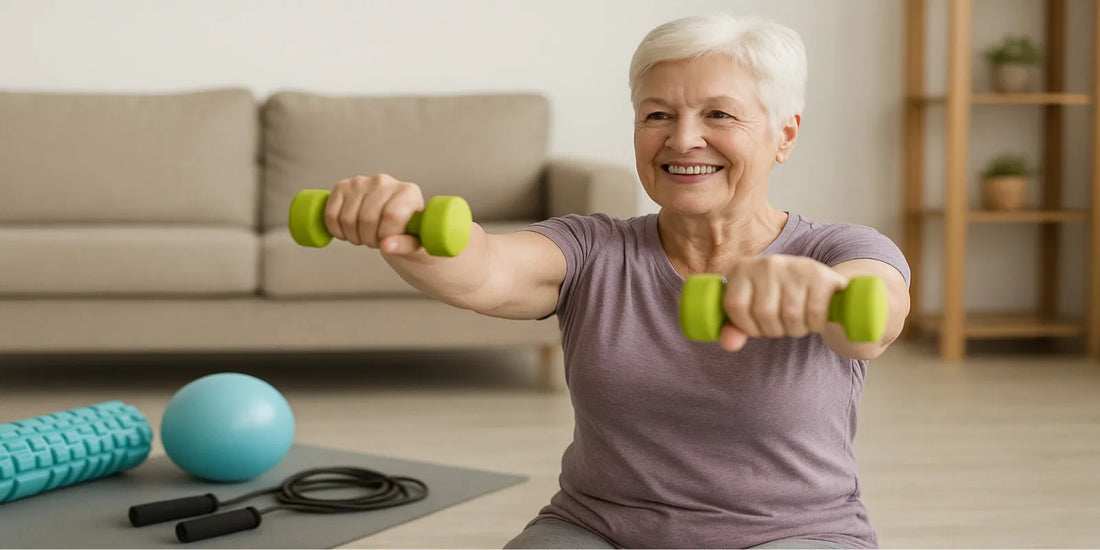
Senior Fitness Tips 2025 – Safe, Easy Routines for Seniors
Share
Senior Fitness Tips for Safe, Easy Progress in 2025

Starting fitness after 50 can feel risky. It does not have to be. The goal is steady energy, better balance, and fewer aches. You can reach that with simple steps. You do not need fancy gear. You need a plan that fits your day.
Many seniors stop because plans feel complex. Let us keep things clear. We will focus on small, safe moves. We will track progress in minutes, not miles. These ideas help joints, heart, and mood. They also build confidence.
Senior fitness tips: start safe, start small
Begin with a five minute warm-up. March in place. Roll shoulders. Breathe slowly. Try ten chair squats. Add a light stretch. If you feel fine, add two more minutes. Small wins reduce fear and build a habit.
- Pick a time you can repeat most days.
- Use a chair or wall for balance at first.
- Stop if pain is sharp or unusual.
- Record minutes, not speed. Consistency matters most.
These senior fitness tips keep the first week gentle. They also prepare you for strength and balance work next.
Senior fitness tips backed by science
Clear rules help you exercise with confidence. Most experts suggest 150 minutes of moderate activity each week. Add two days of strength work. Short sessions add up. Three ten minute walks count.
Trusted sources confirm these targets. See the CDC guidance for older adults. It shows how movement lowers heart risk and improves mood. The National Institute on Aging explains safe strength, balance, and flexibility ideas. The WHO global guidelines outline benefits for longevity and independence. For bone and fall protection, see Harvard Health on strength training.
Why does this matter? Regular movement improves insulin action and sleep. Light strength work preserves muscle. Balance drills cut fall risk. Gentle stretching eases stiffness. Together, these reduce daily stress and pain.
- Walking supports heart health and joint nutrition.
- Strength work protects bones and posture.
- Balance drills train ankles, hips, and attention.
- Stretching restores range without forcing joints.
Use these senior fitness tips as a checklist. Pick one item per day. Add more only when the body feels ready.
Build strength, balance, cardio, and flexibility
Warm-up, 5 minutes: March in place. Circle arms. Tap heels. Breathe through the nose. Keep talkable pace.
Strength, 10 minutes: Do two sets of eight to twelve reps. Try chair squats, wall push-ups, and light rows with bands. Rest forty seconds. Move slowly. Focus on control.
Balance, 5 minutes: Hold a counter. Stand on one foot for twenty seconds. Switch sides. Try heel-to-toe walks. Add gentle head turns when steady.
Cardio, 10 minutes: Walk indoors or outdoors. Use short hills for challenge. Keep effort at six of ten. You should speak in short phrases.
Flexibility, 5 minutes: Stretch calves, hips, chest, and back. Hold each for twenty to thirty seconds. No bouncing. Stop before pain.

Weekly map: Mon, Wed, Fri do strength and balance. Tue, Thu, Sat walk or cycle. Stretch most days. Sunday is rest and light mobility. This simple map keeps variety high and risk low.
Adjust time if you are new. Five minutes per block is fine. These senior fitness tips scale with your energy. Add minutes when recovery feels good. Reduce minutes during busy weeks.
Senior fitness tips for a lasting habit
Make the plan easy to start. Lay out shoes the night before. Book the session in your calendar. Tell a friend. Habit cues beat motivation on slow days.
Protect your body. Sip water before and after. Eat protein with meals to support muscle. Check medicines with a clinician if dizziness appears. Use shoes with grip. Train on flat ground first.
Track simple wins. Write minutes moved. Note energy and sleep quality. Praise consistency, not perfection. If you miss a day, restart with a five minute walk. These senior fitness tips keep momentum strong.
The button above links to our related guide for deeper practice.
